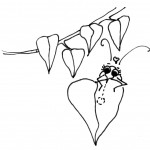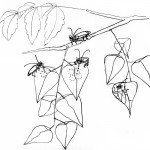BioB provides an opportunity to study many of the bugs in your area. Every species has its own story, its evolutionary history. Here’s the story of one bug species and how humans have shaped it. (The stories of other bugs will follow in the future!)
The red-shouldered soapberry bug, Jadera haematoloma
Before twentieth century development, red-shouldered bugs, Jadera haematoloma, had lived for probably millions of years along the Gulf Coast and southwestern river valleys. They lived on native plants, like the small tree known as soapberry, and on the balloon vine and heart seed plants in the genus Cardiospermum. The bugs slowly sucked juices from the stems and flowers, patiently waiting the plants’ seed pods would ripen and provide a crop of seeds. This was niche living in a literal sense.
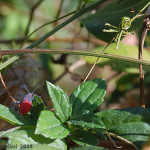 Cardiospermum grows in a habitat that locals called hammock, a dry hardwood forest ecosystem that’s just high enough above sea level not to be regularly inundated. You can still find these hammocks in the interior of some islands in the Florida Keys, in isolated pockets of the Everglades, and in a thin ribbon along the Gulf coast– where its escaped development. Soapberry is similarly sparse in its distribution, limited to moist ravines in states like Texas and Oklamhoma that can be otherwise relatively dry.
Cardiospermum grows in a habitat that locals called hammock, a dry hardwood forest ecosystem that’s just high enough above sea level not to be regularly inundated. You can still find these hammocks in the interior of some islands in the Florida Keys, in isolated pockets of the Everglades, and in a thin ribbon along the Gulf coast– where its escaped development. Soapberry is similarly sparse in its distribution, limited to moist ravines in states like Texas and Oklamhoma that can be otherwise relatively dry.
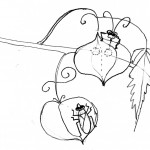
And in this thin ribbon of an ecosystem, plants like Cardiospermum and soapberry, made their living at the margins, literally. Vines don’t have sturdy trunks to get themselves up to sunlight, like trees can. Instead a vein must live at the edge of stand of trees. Or else it waits for a large tree to die and fall, clearing a space in the canopy for it to quickly grow up. These transient, plants living on the edge were the only food source for the Jadera haematoloma, the red-shouldered soapberry bug. If a vine grew large and produced many seeds, then bugs might be able to breed and produce many offspring at that location. Perhaps even multiple generations could pass at one location. But over time, trees would grow up, and the bugs would be forced to starve or to search elsewhere for a host plant.
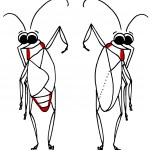 How’s a bug to know what the future holds, much less plan for it? Some insects, such as Jadera have the remarkable ability to place a sort of bet on future conditions. But each bug can only do it once! If a bug grows up with lots to eat and not too many other bugs around, then chances are good that if it stays and breeds there, then its offspring will also be successful, because the environment has lots of food. However, if a bug manages to survive to adulthood, but food is scarce or there’s lots of other bugs to elbow out for access to food, it would probably be worth the risks of flying away on the chance of finding a new source of food with less competition. Bugs can make this gamble just before reaching adulthood. Some adults have long wings and are capable of flying. However, the cost is that they produce fewer offspring. Other adults have short wings, and while they can’t fly, they use the energy they save to produce more offspring where they are. The ability to make this choice is called polyphenism, and its evolution allows a species to deal with unpredictable, but recurring environmental changes, such as the boom and bust seed production of the balloon vine.
How’s a bug to know what the future holds, much less plan for it? Some insects, such as Jadera have the remarkable ability to place a sort of bet on future conditions. But each bug can only do it once! If a bug grows up with lots to eat and not too many other bugs around, then chances are good that if it stays and breeds there, then its offspring will also be successful, because the environment has lots of food. However, if a bug manages to survive to adulthood, but food is scarce or there’s lots of other bugs to elbow out for access to food, it would probably be worth the risks of flying away on the chance of finding a new source of food with less competition. Bugs can make this gamble just before reaching adulthood. Some adults have long wings and are capable of flying. However, the cost is that they produce fewer offspring. Other adults have short wings, and while they can’t fly, they use the energy they save to produce more offspring where they are. The ability to make this choice is called polyphenism, and its evolution allows a species to deal with unpredictable, but recurring environmental changes, such as the boom and bust seed production of the balloon vine.
Even if wing polyphenism is a cool ability, a small and unpredictable environment always increases the chances of extinction for species. So it could have been so easy for these insects, with their narrow ecological specialization, to be driven to extinction, when industrialization and agricultural development began in America. Amazingly, that’s not what happened.
Instead, the bugs moved to the city.
The red-shouldered soapberry bug is a member of a small group of insects, the subfamily Serinethinae. All of these insects feed on plants in the soapberry plant family, Sapindaceae. [Want to hear these names pronounced out loud?] The bugs and the plants have been co-evolving with one another for millions of years, like a long-standing family feud. While some bugs specialized to feed on certain host soapberry family plants, all of them had a suite of characters that adapted them to life on these plants in general.
At some point, humans brought a new soapberry species to Florida. The golden rain tree, Koelreuteria, is an beautiful ornamental plant, with dramatic cascades of yellow flowers in spring. These develop into large bunches of hollow green seed pods in summer that dry to a golden color by fall. These trees were a favorite urban planners and developers because their roots do not crack sidewalks. For these reasons Koelreuteria was widely planted in urban America. There was just one big problem.
Golden rain trees are invasive. Those beautiful golden pods release lots of hardy seeds. And like so many plants that did not evolve in America, golden rain trees have few predators or diseases here to keep their reproductive in check. If you look beneath a golden rain tree, you will probably find many seedlings. These plants are not content to stay where they’ve been planted by humans.
But there is a silver lining to this story of ecological mayhem and potential extinction. Golden rain trees are also members of the Sapindaceae. For millions of years soapberry bugs have fed on the seeds of the Sapindaceae. Despite never having seen or touched a golden rain tree, at some point– we don’t know exactly when– red-shouldered soapberry bugs in Florida started visiting golden rain trees to feed on their seeds. It turns out this was a good move for those bugs. Koelreuteria seeds are nutritious (for a bug!) and they fall in huge numbers a few times each year. The bugs began making what ecologists call a host-shift. By 1950, red-shouldered soapberry bugs in Florida were living full-time on the golden rain trees.
Of course, golden rain trees are not the same plant as soapberry or balloon vine. There would be long periods when the golden rain trees didn’t produce any seeds. Cardiospermum produced fewer seeds, but they did so during a longer part of the year. The seeds have a different nutrient composition. The seed pods that surround the seeds of Koelreuteria are smaller than the seed pods of Cardiospermum. Maybe you’re thinking, So what? They’re close enough. The bugs can survive on the new host plant. End of story. Not even close!
The bugs were just beginning to adapt to life on the golden rain tree. Members of one species aren’t all the same. Just the way people show diversity in all sorts of traits like height, personality, color, taste preferences, and different abilities, animal and plant populations all harbor variation. Small differences that didn’t matter much when the bugs lived on ballon vine might suddenly be important on the golden rain tree. So not all bugs made the host-shift, and some stayed in the hammock.
For the bugs that did start living and breeding on golden rain tree, there was one very noticeable change over time. All soapberry family plants produce a puffy, hollow fruit to keep the bugs away from the developing seeds until they they mature. Then the pods dry and split, allowing the wind to disperse the seeds without them all being eaten by the bugs. However the bugs have evolved a long beak to pierce the pods, allowing adult bugs to reach the best young seeds and jump start their own reproduction early, before the dried pods open and all bugs have access to them. Bugs that had a beak long enough to reach the seeds still in the pods could get more nutrition for themselves (and if their female, for their eggs) than bugs with shorter beaks. However, if a bug used energy to grow a beak longer than it needed to reach the seeds in the pod, then it effective wasted energy on a beak that’s too long. It might even be cumbersome to carry a beak so long! So over many generations, bugs with beak lengths that matched the diameter of the seed pods survived better and left more offspring. The bugs had evolved beak lengths that were adapted to their host plant.
So what happens when the bugs shifted to living on a new host plant, like the golden rain tree, with its smaller pods? In less than 50 years the bugs evolved beak lengths to match the size of the new host plant’s seed pods. The difference was about a 30% change in beak length in about 100 bug generations. The bugs evolved in other characteristics too. The plentiful seed crops produced by golden rain trees caused the bugs to evolve a slightly greater propensity to develop short wings. All while living on and around trees in our cities and suburbs. And eating all these golden rain tree seeds helped limit the spread of this invasive plant.
You’re living in a place where evolutionary change is happening right now.
All this started in Florida. We know this because the bugs that still live on balloon vine in Florida have much more genetic diversity than all the bugs living on golden rain tree. This is just like the story of human evolution. Humans evolved in Africa. Some of them migrated to Asia, Europe, Australia and America, but the humans that stayed in Africa still contains far more genetic diversity than all the people who left. That’s because not all humans undertook the migration out of Africa, and of those that started, many probably didn’t survive.
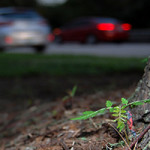 But just like humans, the bugs did not stay where their species first evolved. After adapting to life on golden rain trees, the bugs could now fly from one urban area to another. Golden rain trees were similar throughout the US, because they had been selected by people for ornamental features, not for their ability to resist bugs. Municipalities and private developers trade ideas and soon Koelreuteria was along sidewalks and parking lots from Miami to Washington, DC. North to New York, Long Island, and the Boston suburbs. West to Indiana, California, even in the temperate islands in the desert west created by cities like Salt Lake City. So, since 1950 red-shouldered bugs have been moving north and west, hopping from plant to plant on their new host, provided by people in cities and towns.
But just like humans, the bugs did not stay where their species first evolved. After adapting to life on golden rain trees, the bugs could now fly from one urban area to another. Golden rain trees were similar throughout the US, because they had been selected by people for ornamental features, not for their ability to resist bugs. Municipalities and private developers trade ideas and soon Koelreuteria was along sidewalks and parking lots from Miami to Washington, DC. North to New York, Long Island, and the Boston suburbs. West to Indiana, California, even in the temperate islands in the desert west created by cities like Salt Lake City. So, since 1950 red-shouldered bugs have been moving north and west, hopping from plant to plant on their new host, provided by people in cities and towns.
That’s what we know of the story so far for the red-shouldered soapberry bug. Now we have questions. So many questions. How were the bugs able to adapt to the new host plant so quickly? Was there something special about the bugs in Florida to made that made the host shift happen? What changes what taken place in the bugs’ development, genes and behavior to adapt them to the new host? If the bugs are more likely to be short-winged on the golden rain tree, but only long-wing bugs can fly to new trees and expand their range to the north and west, how has wing polyphenism evolved as they’ve dispersed across the country? Maybe you have other questions too. That’s why scientists are interested in these bugs, and we hope you can help us answer some of these questions!
Acknowledgements
This story draws on the scientific work of Scott Carroll and José Andrés. Illustrations by Serena Graham.

